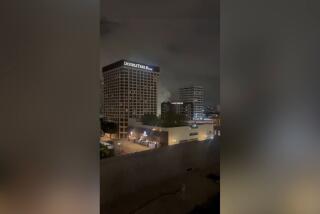Mysterious radio bursts in far parts of universe hint at cataclysm
- Share via
Strange bursts of radio waves from billions of light-years across the universe have puzzled astronomers for more than half a decade, making them question if the signal was even real. Now, in a paper published by the journal Science, researchers say they think they’ve figured out a potential explanation: Something cataclysmic.
What exact cataclysm is causing them, however – merging stars, dying stars, stars being eaten alive – is still up for serious debate.
The first of the four odd bursts was discovered about six years ago in the southern sky. The extremely bright beams would last for mere milliseconds – a fraction of the blink of an eye – and never reappear, leaving researchers at a loss to explain what was causing such mysterious, singular, blazing bursts.
These flashes were coming from a long way off too – which meant they must be powerful events, for their light to reach the Earth. Measuring the distance the light from these bursts had traveled, the scientists found that they had originated from when the Universe was around 6 billion to 9 billion years old – around half the age of the universe, which is 13.8 billion years old.
The scientists have thrown out a few possible explanations. It could be two neutron stars merging; it may be a magnetic neutron star, or magnetar, in its death throes; or perhaps it comes from a black hole having a very stellar meal as it rips a star apart.
In any case, the light from these events may actually reveal new insight into the nature of the intergalactic medium that the radio waves pass through – and it may even help them account for some of the “missing matter” in the universe.
“Further bright [fast radio burst] detections will be a unique probe of the magneto-ionic properties of the [intergalactic medium],” the authors wrote.
These bursts may also be more common than that first strange flash in the sky may have seemed; researchers think these distant “fast radio bursts” must be going off once every 10 seconds in the sky. It’s just a matter of staring at the right patch of the heavens, or getting a radio telescope to stare at an even bigger swath to raise the chances of catching a burst in the act.






